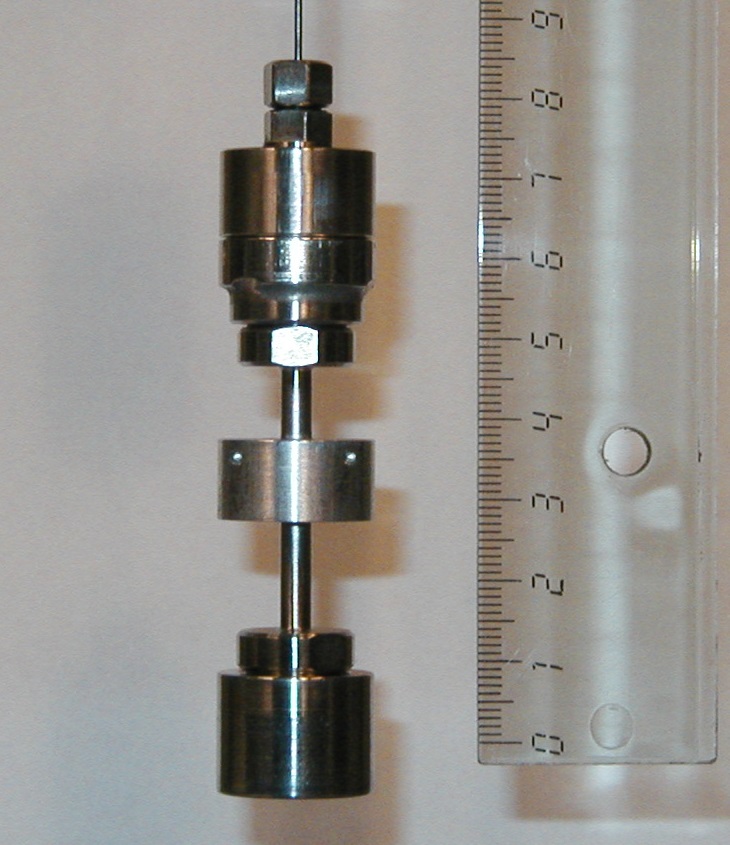The method of sorption calorimetry is designed for studies of hydration of complex organic and biological materials. It has been applied for studies of surfactants [1-4], lipids, DNA and other substances. A sorption calorimetric experiment is performed at isothermal regime, but different temperatures can be studied in separate experiments. In a sorption calorimetric experiment a two-chamber calorimetric cell (see photo) is incerted into a double-twin microcalorimeter [5,6]. A dry substance is placed into one chamber of the calorimetric cell (the sample chamber) and liquid water is injected into the other chamber (the water chamber). Water evaporates, diffuses through the tube connecting the chambers and is absorbed by the studied substance.

From the thermal power of evaporation of water in the water chamber Pvap one can calculate the amount of evaporated water:
\( m_w= \frac{\int{P^{vap}dt}}{H_w^{vap}} \)
and the activity of water in the sample (relative humidity in the sorption chamber):
\( a_w=1-\frac{P^{vap}}{P^{vap,max}} \)
In practice a more complicated formula for calculation of the activity of water based on the corrected Fick’s law is used [7]. From the thermal powers registered in the both chambers one can calculate the partial molar enthalpy of mixing of water:
\( H_w^m=H_w^V (1+\frac{P^S}{P^V} ) \)
During a sorption experiment the water content in the sample increases until it reaches a value high enough to make the process of diffusion of water vapor between the chambers very slow. Then the sorption experiment can be stopped.
For studies of hydration at very high relative humidities we developed a special modification of the method of sorption calorimetry – the desorption calorimetric method [9]. A desorption experiment starts with a fully hydrated sample which is placed in the sample chamber (the top chamber in the figure). In the bottom chamber a salt solution is injected. During the desorption experiment the sample is being slowly dehydrated and the salt solution takes up the water evaporated from the sample.
REFERENCES
- Kocherbitov, V., O. Söderman, and L. Wadsö, Phase Diagram and Thermodynamics of the n-Octyl b-D-Glucoside/Water System. Journal of Physical Chemistry B, 2002. 106(11): p. 2910-2917.
- Kocherbitov, V. and O. Söderman, Glassy Crystalline State and Water Sorption of Alkyl Maltosides. Langmuir, 2004. 20(8): p. 3056-3061.
- Kocherbitov, V. and O. Söderman, Phase diagram and physicochemical properties of the n-octyl alpha-D-glucoside/water system. Physical Chemistry Chemical Physics, 2003. 5(23): p. 5262-5270.
- Kocherbitov, V. and O. Soderman, Hydration of dimethyldodecylamine-N-oxide: Enthalpy and entropy driven processes. Journal of Physical Chemistry B, 2006. 110(27): p. 13649-13655.
- Wadsö, I. and L. Wadsö, A new method for determination of vapour sorption isotherms using a twin double microcalorimeter. Thermochimica Acta, 1996. 271: p. 179-187
- Wadsö, I. and L. Wadsö, A second generation twin double microcalorimeter for measurements of sorption isotherms, heats of sorption and sorption kinetics. Journal of Thermal Analysis and Calorimetry, 1997. 49(2): p. 1045-1052.
- Kocherbitov, V., A New Formula for Accurate Calculation of Water Activity in Sorption Calorimetric Experiments. Thermochimica Acta, 2004. 414(1): p. 43-45.
- Kocherbitov, V., Salt-saturated salt solution as a standard system for sorption calorimetry. Thermochimica Acta, 2004. 421(1-2): p. 105-110.
- Kocherbitov, V. and L. Wadsö, A Desorption Calorimetric Method for Use at High Water Activities. Thermochimica Acta, 2004. 411(1): p. 31-36.